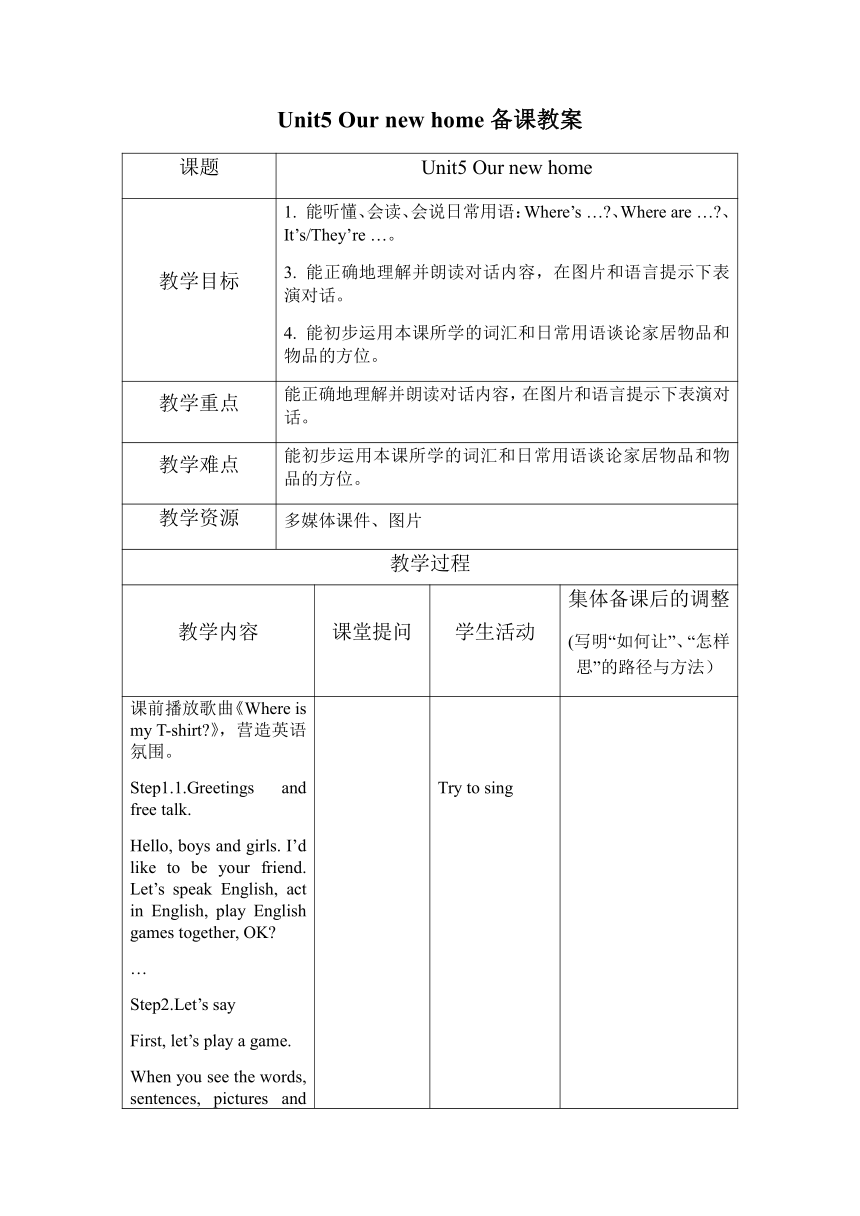Unit 5 Our new home 教案
文档属性
| 名称 | Unit 5 Our new home 教案 |  | |
| 格式 | docx | ||
| 文件大小 | 15.9KB | ||
| 资源类型 | 教案 | ||
| 版本资源 | 牛津译林版 | ||
| 科目 | 英语 | ||
| 更新时间 | 2021-10-13 20:49:08 | ||
图片预览


文档简介
Unit5 Our new home备课教案
课题 Unit5 Our new home
教学目标 1. 能听懂、会读、会说日常用语:Where’s … 、Where are … 、It’s/They’re …。 3. 能正确地理解并朗读对话内容,在图片和语言提示下表演对话。 4. 能初步运用本课所学的词汇和日常用语谈论家居物品和物品的方位。
教学重点 能正确地理解并朗读对话内容,在图片和语言提示下表演对话。
教学难点 能初步运用本课所学的词汇和日常用语谈论家居物品和物品的方位。
教学资源 多媒体课件、图片
教学过程
教学内容 课堂提问 学生活动 集体备课后的调整 (写明“如何让”、“怎样思”的路径与方法)
课前播放歌曲《Where is my T-shirt 》,营造英语氛围。 Step1.1.Greetings and free talk. Hello, boys and girls. I’d like to be your friend. Let’s speak English, act in English, play English games together, OK … Step2.Let’s say First, let’s play a game. When you see the words, sentences, pictures and so on. Please speak it loudly in English. Step3.Presentation 1. Good memory. T:This is Su Yang and Su Hai’ s new home. 出示东西图片(Ask and answer) Where’s... Where are... It’s.... They are... 2. Memory challenge. There are many rooms. There are many things. Where are the things Can you remember Where’s... Where are... It’s.... They are... T:Oh, you have a good memory. Step4.Fun time. T:Yesterday we visited Su Hai and Su Yang’s home.There are many rooms and things. Now please show us your ideal home(课前画好) 2.每个组员逐一展示自己的home Step5.Cartoon time 1.T:You have nice houses. Everyone has a home. Look, Bobby has a house,too. Is it nice Where ‘s Bobby (He’s in the garden)出示cartoon树草丛背景。 2.出示T:Look,Who are they S:Sam bird 出示Picture T:Look at the bird ,Look at its mouth(圈出鸟嘴) T:hungry What would you like ,Bird?(带学生说两遍)。先出句子。 4.Watch the cartoon. T:worm I’d like that. Repeat and read in roles. Step6.Expansion The bird is full. Then he shows Bobby and Sam around his home. (Please try to say.) Step7.Homework. 1. Listen and read cartoon time , try to recite it. 2.Preview Sound time, Song time, Checkout time &Ticking time. What can you see Can you read it? Where is ... / Where are... Where’s... Where are... It’s.... They are... Can you show us your ideal home Who are they How is the bird What would you like ,bird Try to sing Watch and say Answer the questions Ask and answer Work in groups Watch and answer Read in roles Try to say
板书设计
Unit 5 Our new home A: Where’s … B: It’s … A: Where are … B: They are …
课题 Unit5 Our new home
教学目标 1. 能听懂、会读、会说日常用语:Where’s … 、Where are … 、It’s/They’re …。 3. 能正确地理解并朗读对话内容,在图片和语言提示下表演对话。 4. 能初步运用本课所学的词汇和日常用语谈论家居物品和物品的方位。
教学重点 能正确地理解并朗读对话内容,在图片和语言提示下表演对话。
教学难点 能初步运用本课所学的词汇和日常用语谈论家居物品和物品的方位。
教学资源 多媒体课件、图片
教学过程
教学内容 课堂提问 学生活动 集体备课后的调整 (写明“如何让”、“怎样思”的路径与方法)
课前播放歌曲《Where is my T-shirt 》,营造英语氛围。 Step1.1.Greetings and free talk. Hello, boys and girls. I’d like to be your friend. Let’s speak English, act in English, play English games together, OK … Step2.Let’s say First, let’s play a game. When you see the words, sentences, pictures and so on. Please speak it loudly in English. Step3.Presentation 1. Good memory. T:This is Su Yang and Su Hai’ s new home. 出示东西图片(Ask and answer) Where’s... Where are... It’s.... They are... 2. Memory challenge. There are many rooms. There are many things. Where are the things Can you remember Where’s... Where are... It’s.... They are... T:Oh, you have a good memory. Step4.Fun time. T:Yesterday we visited Su Hai and Su Yang’s home.There are many rooms and things. Now please show us your ideal home(课前画好) 2.每个组员逐一展示自己的home Step5.Cartoon time 1.T:You have nice houses. Everyone has a home. Look, Bobby has a house,too. Is it nice Where ‘s Bobby (He’s in the garden)出示cartoon树草丛背景。 2.出示T:Look,Who are they S:Sam bird 出示Picture T:Look at the bird ,Look at its mouth(圈出鸟嘴) T:hungry What would you like ,Bird?(带学生说两遍)。先出句子。 4.Watch the cartoon. T:worm I’d like that. Repeat and read in roles. Step6.Expansion The bird is full. Then he shows Bobby and Sam around his home. (Please try to say.) Step7.Homework. 1. Listen and read cartoon time , try to recite it. 2.Preview Sound time, Song time, Checkout time &Ticking time. What can you see Can you read it? Where is ... / Where are... Where’s... Where are... It’s.... They are... Can you show us your ideal home Who are they How is the bird What would you like ,bird Try to sing Watch and say Answer the questions Ask and answer Work in groups Watch and answer Read in roles Try to say
板书设计
Unit 5 Our new home A: Where’s … B: It’s … A: Where are … B: They are …
